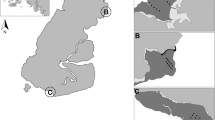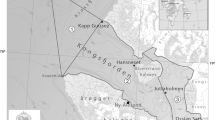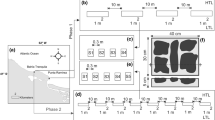Abstract
From 1979 to 1991 the species composition of communities living on hard substrata (hardsub) in the Oosterschelde has been studied — in both the littoral and sublittoral zones. From 1984 onwards, biomass was also measured. This paper deals mainly with the distribution and the development of biomass on sublittoral hardsub in the Oosterschelde. Analysis has shown that the most important abiotic factors regulating the flora and fauna are: quantity and nature of the substrate; sedimentation; exposure to water movement (mainly currents); and light. The construction of the storm-surge barrier has influenced those factors. The main consequences for the flora and fauna on sublittoral hard substrata have been through the increased amount of available hard substratum by about 10% until 1984 and a further 20% from 1984 to 1987, the main barrier construction period). Within the same period (until 1987) the biomass per square metre also increased. This caused a net increase of hardsub biomass — in the sublittoral — of about 35%.
After the barrier was completed sedimentation increased; in some parts of the basin hardsub organisms were covered by sediment and have not recovered; the total quantity of available hard substratum decreased by an amount yet to be established. For the purpose of this paper it is tentatively estimated at 20%, but the process is still going on.
Tidal current velocities are smaller in the post-barrier situation, which caused a shift from more passive suspension feeders to more actively filtering species. The relative importance of suspension feeders on hard substrata has decreased by about 20% after the building of the storm-surge barrier. In 1990 and 1991 it increased again.
Overall water transparency increased, but the lower limit of macroalgal growth has not gone deeper, as nearshore turbulence and turbidity did not change significantly.
Effects on hardsub were small in the beginning. During the construction period (1985–1987) no clear effects were registered. After the completion of the barrier total species diversity increased at first, followed by a decrease from the second half of 1988 onwards. Biomass increased rather sharply, at first, but decreased very sharply in 1989. In 1990 a recovery in biomass became apparent. Developments in biomass and species composition differed per sampling location. An attempt is made to explain some of those developments, in relation to the abiotic changes brought about by the storm-surge barrier. This appeared difficult, because climatic influences obscured the effects of the barrier. The most explicit of those masking effects was brought about by a temporary, huge increase of the brittlestar (Ophiothrix fragilis). This animal covered the substratum in relatively thick layers (up to 5 cm) and more or less suffocated the other fauna. It was therefore difficult to quantify the effect of increased sedimentation on the fauna. The increase of Ophiothrix is probably not caused by the storm-surge barrier, but by a succession of several mild winters.
It is clear that a new equilibrium in the basin is still to be reached. Total effects in terms of species richness and of biomass will continue to be monitored, and the results used to advise the water authorities as to management and nature friendly dike building methods.
Similar content being viewed by others
References
Bayne, B. L. & R. C. Newell, 1983. Physiological energetics of marine molluscs. In: Wilbur & Younge: The Mollusca, Vol. 4, Physiology, part 1. Academic Press.
Braun-Blanquet, J., 1964. Pflanzensociologie, Grundzuege der Vegetationskunde. 3rd edn. Springer-Verlag, Wien-New York.
Coosen, J., F. Twisk, M. W. M. van der Tol, R. H. D. Lambeck, M. R. van Stralen & P. M. Meire, 1994. Variability in stock assessment of cockles (Cerastoderma edule L.) in the Oosterschelde (in , 1980–1990), in relation to environmental factors. Hydrobiologia 282/283: 381–395.
Dahl, A. L., 1973. Surface area in ecological analysis: Quantification of benthic coral-reef algae. Mar. Biol. 23: 239–249.
De Kluijver, M. J., 1989. Sublittoral hard substrate communities of the southern Delta area, SW Netherlands. Bijdragen tot de Dierkunde 59: 141–158.
De Kluijver, M. J. & R. J. Leewis, 1994. Changes in the sublittoral hard substrate communities in the Oosterschelde estuary (SW Netherlands), caused by changes in the environmental parameters. Hydrobiologia 282/283: 265–280.
Dijkema, R., 1993. Shellfish culture in the Netherlands (in press).
Fiala-Médioni, A., 1978a. Filter feeding ethology of benthic invertebrates (Ascidians). III. Recording of water current in situ. Rate and rhythm of pumping. Mar. Biol. 45: 185–190.
Fiala-Médioni, A., 1978b. Filter feeding ethology of benthic invertebrates (Ascidians). IV. Pumping rate, filtration efficiency. Mar. Biol. 48: 243–249.
Frost, T. M., 1976. Sponge feeding: a review with a discussion of some continuing research. In: Harrison F. W. & R. R. Cowden (eds), Aspects of spongebiology. Acad. Press: 283–298.
Gerodette, T. & A. O. Flechsig, 1979. Sediment-induced reduction in the pumping rate of the tropical sponge Verongia lacunosa. Mar. Biol. 55: 103–110.
Gleick, J., 1987. Chaos: making a new science. Viking, New York: 1–314.
Hill, M. O., 1979. TWINSPAN — A FORTRAN program for arranging multivariate data in an ordered two-way table by classification of the individuals and attributes. Ecology and Systematics, Cornell University, Ithaca, New York.
Hiscock, K., 1976. The influence of water movement on the ecology of sublittoral rocky areas. Ph.D.Thesis, Univ. of Wales.
Hiscock, K. & R. Mitchell, 1980. The description and classification of sublittoral epibenthic ecosystems. In: J. H. Price, D. E. G. Irvine and W. F. Farnham (eds): The Shore Environment, Vol. 2: Ecosystems. Acad. Press, London and New York: 323–370.
Holmes, N., 1973. Water transport in the ascidians Styela clava and Ascidiella aspersa. J. exp. mar. Biol. Ecol. 11: 1–13.
Kaandorp, J. A., 1992. Modelling growth forms of biological objects using fractals. Thesis, Univ. of Amsterdam: I–X + 1–158.
Klepper, O., 1989. A model of carbon flows in relation to macrobenthic food supply in the Oosterschelde estuary (S.W.Netherlands). Thesis, Univ. of Wageningen: 1–270.
Klepper, O., M. W. M. van der Tol, H. Scholten & P. M. J. Herman, 1994. SMOES: a simulation model for the Oosterschelde ecosystem. Part I. Description and uncertainty analysis. Hydrobiologia 282/283: 437–451.
LaBarbera, M., 1987. Particle capture by a pacific brittle star. Science 201: 1147–1149.
Leewis, R. J. & A. C. Smaal (in prep.). Filtration activity of several filter feeder groups in the Oosterschelde.
Leewis, R. J. & H. W. Waardenburg, 1989. The flora and fauna of the sublittoral part of the artificial rocky shores in the southwest Netherlands. Progress in Underwater Science 14: 109–122.
Leewis, R. J., H. W. Waardenburg & A. J. M. Meijer, 1989. Active management of an artificial rocky coast. Hydrobiol. Bull. 23: 91–99.
Leewis, R. J. & H. W. Waardenburg, 1990. Flora and fauna of the sublittoral hard substrata in the Oosterschelde (The Netherlands) — interactions with the North Sea and the influence of a storm surge barrier. Hydrobiologia 195: 189–200.
Nienhuis, P. H. & A. C. Smaal, 1994. The Oosterschelde estuary, a case study of a changing ecosystem: an introduction. Hydrobiologia 282/283: 1–14.
Reiswig, H. M., 1971. Particle feeding in natural populations of three marine sponges. Biol. Bull. 141: 568–591.
Reiswig, H. M., 1974. Water transport, respiration and energetica of three tropical marine sponges. J. exp. mar. Biol. Ecol. 14: 231–249.
Randløv, A. & H. U. Riisgard, 1979. Efficiency of particle retention and filtration rate in four species of ascidians. Mar. Ecol. Progr. series 1: 55–59.
Robbins, I. J., 1983. The effects of body size, temperature and suspension density on the filtration and ingestion of inorganic particulate suspensions by ascidians. J. exp. mar. Biol. Ecol. 70: 65–78.
Scholten, H. & M. W. van der Tol, 1994. SMOES: a simulation model for the Oosterschelde ecosystem. Part II: Calibration and validation. Hydrobiologia 282/283: 453–474.
Shumway, S. E., 1978. Respiration, pumping activity and heart rate in Ciona intestinalis exposed to fluctuating salinities. Mar. Biol. 48: 235–242.
Smaal, A. C. & M. van Stralen, 1990. Average annual growth and condition of mussels as function of food sources. Hydrobiologia 195: 179–188.
Van der Tol, M. W. M. & H. Scholten, 1992. Response of the Eastern Scheldt stem to a changing environment: functional or adaptive Neth. J. Sea Res. 30: 175–190.
Van Soest, R. W. M. & S. Weinberg, 1981. Preliminary quantitative assessment of the marine hard substrate communities of Roaringwater Bay. J. of Sherkin Island I: 10–26.
Vogel, S., 1974. Current-induced flow through the sponge Halichondria bowerbanki. Biol. Bull. 147: 443–456.
Warner, G. F., 1984. Diving and Marine Biology. The Ecology of the Sublittoral. Cambridge Univ. Press, Cambridge-New York-Melbourne: 1–210.
Warner, G. F. & J. D. Woodley, 1975. Suspension feeding in the brittle star Ohiothrix fragilis. J. mar. biol. Ass. U.K. 55: 199–210.
Weinberg, S., 1978. The minimal area problem in invertebrate communities of Mediterranean rocky substrata. Mar. Biol. 49: 33–40.
Wetsteyn, L. P. M. J., J. C. H. Peeters, R. N. M. Duin, F. Vegter & P. R. M. de Visscher, 1990. Phytoplankton primary production and nutrients in the Oosterschelde (The Netherlands) during the pre-barrier period 1980–1984. Hydrobiologia 195: 163–177.
Wetsteyn, L. P. M. J. & J. C. Kromkamp, 1994. Turbidity, nutrients and phytoplankton primary production in the Oosterschelde (The Netherlands) before, during and after a large-scale coastal engineering project (1980–1990). Hydrobiologia 282/283: 61–78.
Wolff, W. J., 1968. The Echinodermata of the estuarine region of the rivers Rhine, Meuse and Scheldt, with a list of species occurring in the coastal waters of The Netherlands. Neth. J. Sea Res. 4: 59–85.
Author information
Authors and Affiliations
Rights and permissions
About this article
Cite this article
Leewis, R.J., Waardenburg, H.W. & van der Tol, M.W.M. Biomass and standing stock on sublittoral hard substrates in the Oosterschelde estuary (SW Netherlands). Hydrobiologia 282, 397–412 (1994). https://doi.org/10.1007/BF00024644
Issue Date:
DOI: https://doi.org/10.1007/BF00024644




